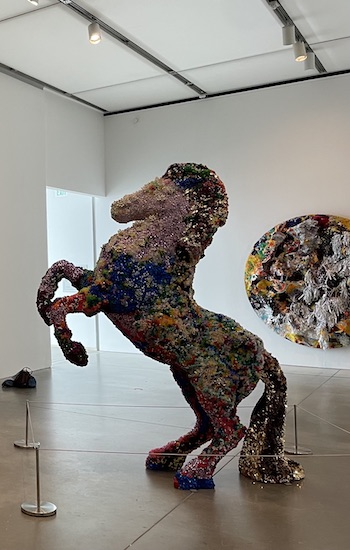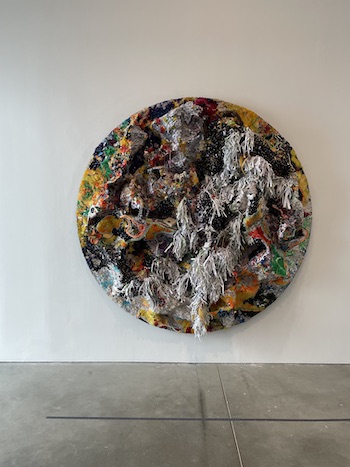Visual Arts Review: “The Treasure House of Memories” — Dreaming of New Pasts
By Chloe Pingeon
At the ICA, artist Raúl de Nieves’s work is playful, joyful, and up for interpretation.

Raúl de Nieves’, “The Fable, which is composed of wonders, moves the more.” Photo: Chloe Pingeon.
The small rectangular gallery for The Treasure House of Memories (through July 24, 2022 at Boston’s ICA) is strikingly silent. Across the hall, the museum’s other installations feature soft music, glowing lights, films that flash side by side. These are displays that try to sweep viewers up into their multimedia. But viewers entering The Treasure House of Memories are met by silence. Without distractions, the eye is immediately drawn to the eight pieces of work by Raúl de Nieves that sit on display. In the midst of whiteness, the vivid colors of the sculptures, collages, and tapestries vibrantly pop out. A brief title and description of the exhibition are inscribed on the gallery walls in black font. Beneath the heading, a quote:
“Go into yourself and see how deep the pace is from which your life flows” — Rainer Maria Rilke
The invitation posed by Rilke’s words has shaped The Treasure House of Memory. Viewers are asked to meditate on what they see, to assess individual pieces through the wider lens of their own memories and experiences … free of multimedia demands for their attention.
Raúl de Nieves is currently based in Brooklyn, but the artist was born in 1983 in Michoacán, Mexico. On his website, Nieves attributes his vision to his childhood in Mexico. And at the ICA it is clear his show draws inspiration from a wide span of Mexican culture, ranging from queer club fashion to religious traditions and historic mythologies. The details in Nieves’s work are overwhelming: it is impossible to grasp and conceptualize every reference hidden within the beaded folds and cardboard ridges of the sculptures and tapestries. But that is the point, at least for those who are not deeply familiar with Mexican culture. Viewers are not given a concrete sense of the narratives and beliefs on crowded display. What we see are fragments of stories, masses of color, beads, paper, and fabric. Something completely new is created out of the old. New memories fashioned out of the shards of the past.
The exhibit opens with an oil painting on a wooden room divider titled The Battle of Saint George and the Dragon. In bright shades of blue, pink, and purple, the painting depicts a saint on horseback destroying a dragon who is demanding a human sacrifice. It is the show’s least abstract piece. Nearby sit three beaded sculptures of a human body and a horse’s head in various stages of transformation, titled, respectively, Mare of Nines, Mare of Threes, Mare of Thirty-Threes. The completed metamorphosis is the exhibition’s triumphant centerpiece: a rearing sculpture of a glimmeringly beaded horse titled The Fable, which is composed of wonders, moves the more.
Taking up an entire wall is a paper tapestry. Its base is composed of black and white collage, but then come layered collections of flowers, feathers, and green vines. A pink centerpiece features cutouts of clowns, toys, and a semi-hidden picture of children’s legs. Who Would We Be Without Our Memories?, asks the title.

Raúl de Nieves’ “The Leap Into the Sun.” Photo: Chloe Pingeon.
Perhaps the most striking piece in the installation is a large circular collage placed on the back wall, near the exit. The collage is titled “The Leap Into the Sun.” At first glance, the image seems to be animated; as the eye travels from right to left, the piece appears to be in motion. The left side displays fluorescent beads. The middle is composed of paper strings dangling over layers of objects and motifs: plastic butterflies, a skull cross, printed biblical images. Tucked into a fold sits a small gift box sealed with green and purple pins. It is inscribed with a handwritten note: “FOR UR NEXT SPELL MAKE IT HAPPEN.” The right side of the piece transitions back into layers of beaded patterns spread over collages of wrapping paper and fabric. The colors here are subtly muted in contrast to the neons on the left. If you choose to look at the piece from top to bottom, there’s another visual order. A frame made of yellow beads encloses a sun that commands attention. A brown plastic eagle head emerges from out of a cardboard ridge. A sculpted head of a lion (or is it a person?) is tucked beneath a waterfall of paper shreds.
The gallery description of “The Leap into the Sun” is brief; it only lists the material used. What you make of this dense concatenation of images and symbols is up to interpretation (or would that be interpretations?) — each perspective changes what you make of this globe.
The artist’s intent is to trigger the subjectivity of viewers, to make us, as Rilke would have it, go into ourselves. A staff member at the ICA told me that a visitor a few days earlier took in the exhibition after a trip to the aquarium and remarked that the sculptures reminded him of sea coral at the bottom of the ocean. The comparison had not occurred to me before, but it makes illuminating sense. We confront Nieves’ heritage through shape-shifting storytelling, which forces us to imagine a new past with each encounter.
Chloe Pingeon is a rising senior at Boston College studying film and journalism. She has written regularly for the features and arts section of Boston College’s Independent Student Newspaper The Heights, and has also written for the culture section of Lithium Magazine. She is currently a creative development intern at Foundation Films.

An astonishing well-written and enticing review, grabs the reader in from start to finish, beautifully illuminating Nieves’ art and delightfully inviting us to view this exhibition.